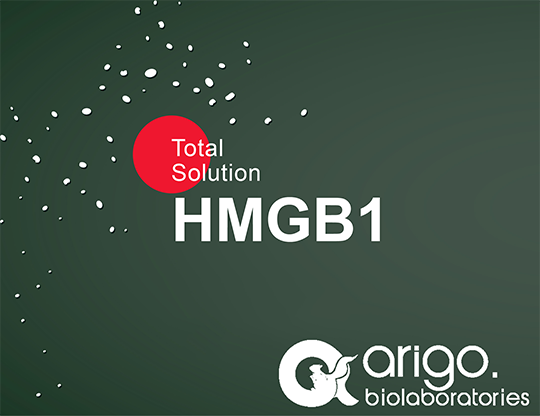Written by Emily Locke
Natural killer cells have the remarkable ability to specifically recognize tumor cells and eliminate them by releasing a deadly cocktail of proteins. A research team led by Dr. Georg Gydnia from the Institute of Pathology at Heidelberg University Hospital identified High Mobility Group Box 1 (HMGB1) protein as a particularly potent endogenous weapon within this cytotoxic mixture [1, 2]. The Heidelberg researchers demonstrated that HMGB1 inhibits glucose-mediated aerobic respiration, thereby triggering metabolic cell death [1, 2]. These findings have brought the protein into the spotlight as a potential candidate for novel immunotherapeutic approaches in cancer treatment.
But HMGB1 is not only relevant in the context of tumor biology and immune defense: the protein fulfills a variety of complex functions in a wide range of physiological and pathological processes – making it a major focus of current research worldwide. For scientists studying HMGB1 in their projects, our partner Arigo Biolaboratories offers a specialized selection of high-quality reagents. The product range includes an active, recombinant HMGB1 protein, specific antibodies for detection and neutralization, as well as various ELISA kits – perfectly tailored to meet the demands of modern laboratory applications!
These topics await you:
1) The Function of HMGB1 in the Cell Nucleus
2) HMGB1 as a Versatile Key Protein in Health and Disease
3) Exploring the Many Faces of HMGB1 with Arigo Biolaboratories
Subscribe to the free Biomol Newsletter and never miss a Blog Article again!
The Function of HMGB1 in the Cell Nucleus
HMGB1 belongs to the family of chromatin-associated High Mobility Group Box proteins, a class of DNA-binding proteins. The protein, approximately 30 kDa in size, is encoded in the human genome on chromosome 13q12 and consists of 215 amino acids, including two nuclear localization sequences. Its structure features two positively charged DNA-binding domains – the so-called A box and B box – as well as an acidic C-terminal region rich in asparagine and glutamate residues [3].
In the nucleus, HMGB1 binds non-specifically to the minor groove of DNA, inducing bending of the double helix. This conformational change facilitates the binding of additional DNA-associated proteins. By interacting with nucleosomes, transcription factors, and histones, HMGB1 plays a key role in regulating gene expression [3].
Whether HMGB1 remains in the nucleus or is exported to the cytosol depends largely on post-translational modifications. In its non-acetylated form, it stays within the nucleus. However, hyperacetylation or modification of specific lysine residues can trigger its translocation into the cytoplasm – where HMGB1 acts as a sensor for immunogenic nucleic acids and contributes to the activation of the immune response [4].
HMGB1 as a Versatile Key Protein in Health and Disease
Research in recent years has identified HMGB1 as a central molecule involved in various pathological processes. Particularly in severe disease courses such as sepsis or malaria, elevated concentrations of the protein have been detected in the blood. HMGB1 can be released passively by necrotic cells or actively secreted by immune cells such as monocytes, macrophages, and dendritic cells – typically during the later stages of the immune response. In both cases, HMGB1 acts as an endogenous danger signal (alarmin) and plays a crucial role in driving the systemic inflammatory response [3].
Moreover, HMGB1 has also been linked to the pathogenesis of various autoimmune and rheumatic diseases. Its proinflammatory effects are mediated, among other mechanisms, through interactions with receptors such as TLR-2, TLR-4, and RAGE – often in conjunction with cytokines and other inflammatory mediators [5]. Targeted inhibition of HMGB1 – for example, through monoclonal antibodies – is therefore considered a promising approach for the development of new therapies for inflammatory and systemic diseases.
Came to stay? Follow us on LinkedIn!
Exploring the Many Faces of HMGB1 with Arigo Biolaboratories
Studying a protein as complex as HMGB1 requires reliable, high-precision reagents. With products from our partner Arigo Biolaboratories, researchers are ideally equipped to investigate the diverse functions and mechanisms of action of HMGB1.
Arigo offers validated mono- and polyclonal antibodies for applications such as ELISA, flow cytometry, Western blot, and immunohistochemistry. For functional assays or as a standard in SDS-PAGE, an active, recombinant HMGB1 protein with a C-terminal His-tag is available. And for the quantitative detection of HMGB1 in human, mouse, or rat samples – such as plasma, serum, cell culture supernatants, or lysates – Arigo provides species-cross-reactive ELISA kits.
What Arigo Offers for Your HMGB1 Research:
- Highly specific antibodies for various applications
- High-purity recombinant HMGB1 protein with C-terminal His-tag
- Versatile ELISA kits for human, mouse, or rat samples
Save now: Take advantage of our exclusive 20% discount on HMGB1 products from Arigo Biolaboratories! For more details, check out the campaign flyer. Curious for more? Take a look at Arigo’s catalogs or browse the entire Arigo product portfolio.
Sources
[1] Gdynia, G., Sauer, S., Kopitz, J. et al. The HMGB1 protein induces a metabolic type of tumour cell death by blocking aerobic respiration. Nat Commun 7, 10764 (2016).
[2] Cerwenka, A., Kopitz, J., Schirmacher, P., Roth, W., & Gdynia, G. (2016). HMGB1: The metabolic weapon in the arsenal of NK cells. Molecular & Cellular Oncology, 3(4).
[3] Klune, J.R., Dhupar, R., Cardinal, J. et al. HMGB1: Endogenous Danger Signaling. Mol Med 14, 476–484 (2008).
[4] Bonaldi T, Talamo F, Scaffidi P, Ferrera D, Porto A, Bachi A, Rubartelli A, Agresti A, Bianchi ME. Monocytic cells hyperacetylate chromatin protein HMGB1 to redirect it towards secretion. EMBO J. 2003 Oct 15;22(20):5551-60.
[5] Pisetsky DS, Erlandsson-Harris H, Andersson U. High-mobility group box protein 1 (HMGB1): an alarmin mediating the pathogenesis of rheumatic disease. Arthritis Res Ther. 2008;10(3):209.
Preview Image: https://www.arigobio.com/hmgb1, 20.04.2025.








